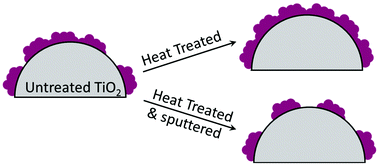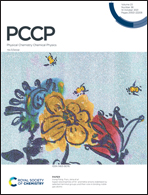Influence of TiO2 surface defects on the adsorption of N719 dye molecules†
Abstract
Surface defects influence the dye adsorption on TiO2 used as a substrate in dye-sensitized solar cells (DSSCs). In this study, we have used different Ar+ sputtering doses to create a controlled density of defects on a TiO2 surface exposed to different pre-heating temperatures in order to analyse the influence of defects on the N719 dye adsorption. TiO2 was pre-treated using two different treatments. The first treatment involved heating to 200 °C with subsequent sputtering at different doses. The second treatment included heating only, but at four different temperatures starting at 200 °C. After the pre-treatments, the TiO2 samples were immersed into an N719 dye solution for 24 hours at room temperature to dye the TiO2 substrates. The amount of Ti3+ surface defects introduced by the different pre-treatments and their influence on dye adsorption onto the TiO2 surface were examined by X-ray photoelectron spectroscopy (XPS), ultraviolet photoelectron spectroscopy (UPS) and metastable induced electron spectroscopy (MIES). Neutral impact collision ion scattering spectroscopy (NICISS) was used to determine the coverage of the TiO2 surface by adsorbed dye molecules. It was found that Ti3+ surface defects were formed by Ar+ sputtering but not by pre-treatment through heating alone. MIES analysis of the outer-most layer and density of states calculations show that the thiocyanate ligand of the N719 dye becomes directed away from the TiO2 surface. Both XPS and NICISS results indicate that the amount of adsorbed N719 dye decreases with increasing density of Ti3+ surface defects. Thus, the generation of surface defects reduces the ability of the TiO2 surface to adsorb the dye molecules. Heating alone as pre-treatment of the TiO2 substrates instead increases the dye adsorption, without causing detectable defects on the TiO2 surface.



 Please wait while we load your content...
Please wait while we load your content...